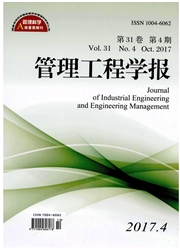

 中文摘要:
中文摘要:
在销售商面临资金约束的供应链中,通过供应商向销售商提供赊销的内部融资模式,可以缓解供应链的资金不足问题,改善供应链的绩效。在市场需求不确定的条件下,分别研究了批发价格契约与回购契约对资金约束型供应链的协调问题,并分析了销售商初始资金强弱对契约参数的影响。研究表明:赊销背景下,传统批发价格契约无法协调存在资金约束的供应链;而当销售商分享链利润的比例满足一定条件时,回购契约能够实现资金约束型供应链的协调,且批发价格随销售商初始资金的增大而减小,回购价格随初始资金的增大而增大。最后通过数值分析对结论进行了验证。
 英文摘要:
英文摘要:
Trade credit is a seller's short-time loan to the buyer, allowing the buyer to make a delay payment to the seller. It has been the largest source of working capital for the firms, especially for those with insufficient initial capital. It has also been an important issue in supply chain management because it enables the retailer to increase the order quantity. Meanwhile, as a tool for supply chain coordination, trade credit chiefly promotes its channel motivation by means of supplier's share for the demand uncertainty with the retailers. However, the impact of trade credit on supply chain coordination has not been sufficiently studied by academia in the supply chain field. A supply chain consists of a supplier and a retailer with capital constraints. Following the newsvendor model, this paper focuses on supply chain coordination mechanisms by assuming that the supplier grants trade credit to the retailer. Under a random demand and the retailer's limited liability, two mechanisms are discussed for investigation: (i) wholesale price contract, and (ii) buyback conlract. This paper first investigates the wholesale price contract using the Stackelberg game. Given the context of a contract (co,Q), the retailer uses the internalcapital, A first for the payment, and finances the rest of the payment coO- A from the supplier by delaying it with the sales revenue p min (x,Q) at the endof the sale period. It is shown that using trade credit and the wholesale price contract, the supplier shares the risk of F(x)dx for the retailer. However,this contract fails to coordinate the capital constrained supply chain. In the second part, the model ofbuybaek eontract based on trade credit {ω,b,Q} is developed. When granting trade credit andbuybacks, the retailer uses the internal capital, A first for the payment. At the end of the sale period, the supplier buys unsold items back at rate b and then the retailer pays the debtcoQ-Awith the sales revenuepmin(x,Q)+b[Q-min(Q,x)]. Hence, the
 同期刊论文项目
同期刊论文项目
 同项目期刊论文
同项目期刊论文
 期刊信息
期刊信息
